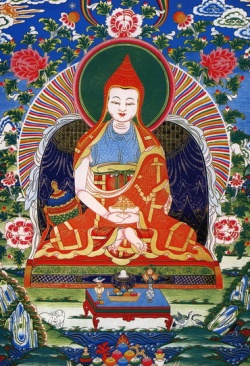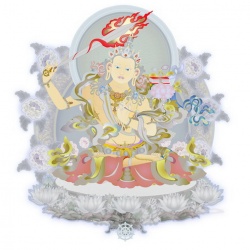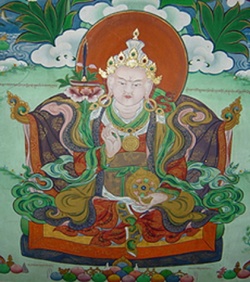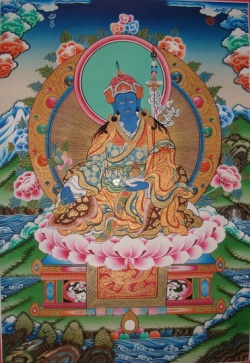Difference between revisions of "Vima Nyingtik"
| Line 1: | Line 1: | ||
[[File:Vimalamitra332.jpg|thumb|250px|]][[File:Mandzhushri-troonil.JPG|thumb|250px|]][[File:Trisong-Detsen-sm1.jpg|thumb|250px|]][[File:Urgyen-menla.jpg|thumb|250px|]] | [[File:Vimalamitra332.jpg|thumb|250px|]][[File:Mandzhushri-troonil.JPG|thumb|250px|]][[File:Trisong-Detsen-sm1.jpg|thumb|250px|]][[File:Urgyen-menla.jpg|thumb|250px|]] | ||
| − | |||
| − | The [[Vima Nyingtik]] itself consists of [[tantras]] ([[rgyud]]), [[agamas]] ([[lung]]), and [[Upadesha]] ([[man ngag]]). The [[tantras]] here refer to the [[Seventeen Tantras]]. [[Chogyal Namkhai Norbu|Namkhai]] (1991) & [[Vajranatha]] (1996: p.18) hold that [[agamas]] that pertain to the [[Vima Nyingtik]] were compiled by [[Vimalamitra]] (fl. 8th century) and are known as the "[[five series]]" ( | + | |
| + | |||
| + | |||
| + | |||
| + | [[Vima Nyingthig]], "Seminal Heart of [[Vimalamitra]]", is one of the two "seminal heart" collections of the [[menngagde]] cycle [[Dzogchen]], the other one being "Seminal Heart of the Dakini" ([[mkha' 'gro snying thig]]). Traditionally the teachings are ascribed to [[Vimalamitra]], but they were codified and collated by their Tibetan discoverers in the 11th and 12th century. | ||
| + | |||
| + | |||
| + | [[Vima Nyingthig]] or "[[Vimalamitras Seminal Heart]]" ([[Tibetan]]: {{BigTibetan|[[བི་མ་སྙིང་ཐིག་]]}}; [[Wylie]]: [[bi ma snying thig]]) is a practice [[lineage]] of [[Mantrayana]]. It is one of the [[nyingthig]] or [[seminal heart]] ([[Tibetan]]: {{BigTibetan|[[སྙིང་ཐིག]]}}, [[Wylie]]: [[snying thig]]) teachings of the [[Mennagde]] cycle of [[Dzogchen]] and was codified and collated by [[Longchenpa|Longchenpa]] (1308–1364?) in the fourteenth century. | ||
| + | |||
| + | The [[Mennagde]] all convey teachings and practices on [[Trekcho|Trekcho]] in a largely comparable [[manner]] but it is in their presentation of [[Togal]] that they greatly differ. | ||
| + | |||
| + | The [[Vima Nyingtik]] itself consists of [[tantras]] ([[rgyud]]), [[agamas]] ([[lung]]), and [[Upadesha]] ([[man ngag]]). The [[tantras]] here refer to the [[Seventeen Tantras]]. [[Chogyal Namkhai Norbu|Namkhai]] (1991) & [[Vajranatha]] (1996: p.18) hold that [[agamas]] that pertain to the [[Vima Nyingtik]] were compiled by [[Vimalamitra]] (fl. 8th century) and are known as the "[[five series]]" | ||
| + | |||
| + | The [[Vima Nyingtik]] itself consists of three sections: | ||
| + | |||
| + | |||
| + | [[tantras]] ([[rgyud]], which refer to the [[Seventeen Tantras]]; | ||
| + | [[āgamas]] ([[lung]]), which are largely [[Tibetan]] syntheses; | ||
| + | [[upadēśavargas]] ([[man ngag]]); these refer to 119 treatises of [[pith]] advice | ||
| + | |||
| + | |||
[[sde tshan lnga]]), are the "[[Golden Letters]]" ( | [[sde tshan lnga]]), are the "[[Golden Letters]]" ( | ||
| Line 15: | Line 34: | ||
The [[Vima Nyingthig]] denotes the teachings both for and of the [[scholars]] or [[Pandita]] ([[Tibetan]]: {{BigTibetan|[[རྒྱ་ཆའེ་བ]]}}, [[Wylie]]: [[rgya ch'e ba]]), brought to [[Tibet]] by [[Vimalamitra]]. | The [[Vima Nyingthig]] denotes the teachings both for and of the [[scholars]] or [[Pandita]] ([[Tibetan]]: {{BigTibetan|[[རྒྱ་ཆའེ་བ]]}}, [[Wylie]]: [[rgya ch'e ba]]), brought to [[Tibet]] by [[Vimalamitra]]. | ||
| + | |||
==[[Troma Tantra]]== | ==[[Troma Tantra]]== | ||
| + | |||
The "[[Troma Tantra]]" or the "[[Ngagsung Tromay Tantra]]" otherwise known as the "[[Ekajaṭĭ Khros Ma'i rGyud]]" focuses on [[rites]] of the [[protector]], [[Ekajati]]. | The "[[Troma Tantra]]" or the "[[Ngagsung Tromay Tantra]]" otherwise known as the "[[Ekajaṭĭ Khros Ma'i rGyud]]" focuses on [[rites]] of the [[protector]], [[Ekajati]]. | ||
| + | |||
==[[Seventeen Tantras]]== | ==[[Seventeen Tantras]]== | ||
| + | |||
The "[[Seventeen Tantras]] of the [[esoteric]] instruction cycle" ([[Tibetan]]: {{BigTibetan|[[མན་ངག་སྡེའི་རྒྱུད་བཅུ་བདུན]]}}, [[Wylie]]: [[man ngag sde'i rgyud bcu bdun]] ) which are supports for the [[Vima Nyingthig]] are as follows (in no particular order): | The "[[Seventeen Tantras]] of the [[esoteric]] instruction cycle" ([[Tibetan]]: {{BigTibetan|[[མན་ངག་སྡེའི་རྒྱུད་བཅུ་བདུན]]}}, [[Wylie]]: [[man ngag sde'i rgyud bcu bdun]] ) which are supports for the [[Vima Nyingthig]] are as follows (in no particular order): | ||
| Line 30: | Line 53: | ||
# '[[Self-liberated Primordial Awareness|Self-liberated Primordial Awareness]]' ([[Tibetan]]: {{BigTibetan|[[རིག་པ་རང་གྲོལ]]}}, [[Wylie]]: [[rig pa rang grol]]) | # '[[Self-liberated Primordial Awareness|Self-liberated Primordial Awareness]]' ([[Tibetan]]: {{BigTibetan|[[རིག་པ་རང་གྲོལ]]}}, [[Wylie]]: [[rig pa rang grol]]) | ||
# '[[Piled Gems|Piled Gems]]' ([[Tibetan]]: {{BigTibetan|[[རིན་པོ་ཆེ་སྤུང་བ]]}}, [[Wylie]]: [[rin po che spung ba]]) | # '[[Piled Gems|Piled Gems]]' ([[Tibetan]]: {{BigTibetan|[[རིན་པོ་ཆེ་སྤུང་བ]]}}, [[Wylie]]: [[rin po che spung ba]]) | ||
| + | |||
# '[[Shining Relics of Enlightened Body|Shining Relics of Enlightened Body]]' ([[Tibetan]]: {{BigTibetan|[[སྐུ་གདུང་འབར་བ]]}}, [[Wylie]]: [[sku gdung 'bar ba]]) | # '[[Shining Relics of Enlightened Body|Shining Relics of Enlightened Body]]' ([[Tibetan]]: {{BigTibetan|[[སྐུ་གདུང་འབར་བ]]}}, [[Wylie]]: [[sku gdung 'bar ba]]) | ||
| Line 36: | Line 60: | ||
# '[[Great Auspicious Beauty|Great Auspicious Beauty]]' ([[Tibetan]]: {{BigTibetan|[[བཀྲ་ཤིས་མཛེས་ལྡན]]}}, [[Wylie]]: [[bkra shis mdzes ldan]]) | # '[[Great Auspicious Beauty|Great Auspicious Beauty]]' ([[Tibetan]]: {{BigTibetan|[[བཀྲ་ཤིས་མཛེས་ལྡན]]}}, [[Wylie]]: [[bkra shis mdzes ldan]]) | ||
# '[[The Mirror of the Heart of Vajrasattva|The Mirror of the Heart of Vajrasattva]]' ([[Tibetan]]: {{BigTibetan|[[རྡོ་རྗེ་སེམས་དཔའ་སྙིང་གི་མེ་ལོང]]}}, [[Wylie]]: [[rdo rje sems dpa' snying gi me long]]) | # '[[The Mirror of the Heart of Vajrasattva|The Mirror of the Heart of Vajrasattva]]' ([[Tibetan]]: {{BigTibetan|[[རྡོ་རྗེ་སེམས་དཔའ་སྙིང་གི་མེ་ལོང]]}}, [[Wylie]]: [[rdo rje sems dpa' snying gi me long]]) | ||
| + | |||
# '[[The Mirror of the Mind of Samantabhadra|The Mirror of the Mind of Samantabhadra]]' ([[Tibetan]]: {{BigTibetan|[[ཀུན་ཏུ་བཟང་པོ་ཐུགས་ཀྱི་མེ་ལོང]]}}, [[Wylie]]: [[kun tu bzang po thugs kyi [[me long]]) | # '[[The Mirror of the Mind of Samantabhadra|The Mirror of the Mind of Samantabhadra]]' ([[Tibetan]]: {{BigTibetan|[[ཀུན་ཏུ་བཟང་པོ་ཐུགས་ཀྱི་མེ་ལོང]]}}, [[Wylie]]: [[kun tu bzang po thugs kyi [[me long]]) | ||
| + | |||
# '[[Direct Introduction|Direct Introduction]]' ([[Tibetan]]: {{BigTibetan|[[ངོ་སྤྲོད་སྤྲས་པ]]}}, [[Wylie]]: [[ngo sprod spras pa]]) | # '[[Direct Introduction|Direct Introduction]]' ([[Tibetan]]: {{BigTibetan|[[ངོ་སྤྲོད་སྤྲས་པ]]}}, [[Wylie]]: [[ngo sprod spras pa]]) | ||
| Line 43: | Line 69: | ||
# '[[Sixfold Expanse of Samantabhadra|Sixfold Expanse of Samantabhadra]]' ([[Tibetan]]: {{BigTibetan|[[ཀུན་ཏུ་བཟང་པོ་ཀློང་དྲུག]]}}, [[Wylie]]: [[kun tu bzang po klong drug]]) | # '[[Sixfold Expanse of Samantabhadra|Sixfold Expanse of Samantabhadra]]' ([[Tibetan]]: {{BigTibetan|[[ཀུན་ཏུ་བཟང་པོ་ཀློང་དྲུག]]}}, [[Wylie]]: [[kun tu bzang po klong drug]]) | ||
# '[[Blazing Lamp|Blazing Lamp]]' ([[Tibetan]]: {{BigTibetan|[[སྒྲོན་མ་འབར་བ]]}}, [[Wylie]]: [[sgron ma 'bar ba]]) | # '[[Blazing Lamp|Blazing Lamp]]' ([[Tibetan]]: {{BigTibetan|[[སྒྲོན་མ་འབར་བ]]}}, [[Wylie]]: [[sgron ma 'bar ba]]) | ||
| + | |||
# '[[Union of the Sun and Moon|Union of the Sun and Moon]]' ([[Tibetan]]: {{BigTibetan|[[ཉི་ཟླ་ཁ་སྦྱོར]]}}, [[Wylie]]: [[nyi zla kha sbyor]]) | # '[[Union of the Sun and Moon|Union of the Sun and Moon]]' ([[Tibetan]]: {{BigTibetan|[[ཉི་ཟླ་ཁ་སྦྱོར]]}}, [[Wylie]]: [[nyi zla kha sbyor]]) | ||
| Line 49: | Line 76: | ||
These [[Seventeen Tantras]] are to be found in the [[Canon of the Ancient School]], the [[Nyingma Gyubum]] ([[Tibetan]]: {{BigTibetan|[[རྙིང་མ་རྒྱུད་འབུམ]]}}, [[Wylie]]: [[rnying ma rgyud 'bum]]), volumes 9 and 10, folio numbers 143–159 of the edition edited by [[Jamyang Khyentse]] [[Rinpoche]] commonly known as [[Dilgo Khyentse Rinpoche]] ([[Thimpu]], [[Bhutan]], 1973), reproduced from the {{Wiki|manuscript}} preserved at [[Tingkye Gonpa Jang]] ([[Tibetan]]: {{BigTibetan|[[གཏིང་སྐྱེས་དགོན་པ་བྱང]]}}, [[Wylie]]: [[gting skyes dgon pa byang]]) [[Monastery]] in [[Tibet]]. | These [[Seventeen Tantras]] are to be found in the [[Canon of the Ancient School]], the [[Nyingma Gyubum]] ([[Tibetan]]: {{BigTibetan|[[རྙིང་མ་རྒྱུད་འབུམ]]}}, [[Wylie]]: [[rnying ma rgyud 'bum]]), volumes 9 and 10, folio numbers 143–159 of the edition edited by [[Jamyang Khyentse]] [[Rinpoche]] commonly known as [[Dilgo Khyentse Rinpoche]] ([[Thimpu]], [[Bhutan]], 1973), reproduced from the {{Wiki|manuscript}} preserved at [[Tingkye Gonpa Jang]] ([[Tibetan]]: {{BigTibetan|[[གཏིང་སྐྱེས་དགོན་པ་བྱང]]}}, [[Wylie]]: [[gting skyes dgon pa byang]]) [[Monastery]] in [[Tibet]]. | ||
| + | |||
| + | |||
| + | |||
==[[Lineage]]== | ==[[Lineage]]== | ||
| + | |||
[[Kumaradza]] was a senior [[disciple]] of [[Melong Dorje]] (1243–1303). [[Kumaradza]] studied with the grand [[master]] [[Orgyenpa]] (1230–1309), who conveyed teachings of "[[Vimalamitra's Seminal Heart]]" ([[Tibetan]]: {{BigTibetan|[[བི་མ་སྙིང་ཐིག]]}}{{BigTibetan|་}}; [[Wylie]]: [[bi ma snying thig]]) upon him. | [[Kumaradza]] was a senior [[disciple]] of [[Melong Dorje]] (1243–1303). [[Kumaradza]] studied with the grand [[master]] [[Orgyenpa]] (1230–1309), who conveyed teachings of "[[Vimalamitra's Seminal Heart]]" ([[Tibetan]]: {{BigTibetan|[[བི་མ་སྙིང་ཐིག]]}}{{BigTibetan|་}}; [[Wylie]]: [[bi ma snying thig]]) upon him. | ||
| + | |||
| + | |||
==[[Testaments of the knowledge-holders]]== | ==[[Testaments of the knowledge-holders]]== | ||
| + | |||
"The [[Posthumous Teachings of the Vidyadhara]]" ([[Tibetan]]: {{BigTibetan|[[རིག་འཛིན་གྱི་འདས་རྗེས]]}}, [[Wylie]]: [[rig 'dzin gyi 'das-rjes]]) are found in the [[Vima Nyingtik]]. These are the last testaments of the early [[vidyadharas]]: [[Garab Dorje], [[Manjushrimitra]], [[Shri Singha]] and [[Jnanasutra]]. These testaments are post-humous as they were delivered by the [[vidhyadhara]] to their senior [[disciple]] from within a [[bindu|thigle]] of the [[Five Pure Lights]] in their [[Rainbow body|Rainbow Body of Light]]. | "The [[Posthumous Teachings of the Vidyadhara]]" ([[Tibetan]]: {{BigTibetan|[[རིག་འཛིན་གྱི་འདས་རྗེས]]}}, [[Wylie]]: [[rig 'dzin gyi 'das-rjes]]) are found in the [[Vima Nyingtik]]. These are the last testaments of the early [[vidyadharas]]: [[Garab Dorje], [[Manjushrimitra]], [[Shri Singha]] and [[Jnanasutra]]. These testaments are post-humous as they were delivered by the [[vidhyadhara]] to their senior [[disciple]] from within a [[bindu|thigle]] of the [[Five Pure Lights]] in their [[Rainbow body|Rainbow Body of Light]]. | ||
In this [[tradition]], the [[thigle]] is understood to be comparable to a [[Pure Land|pure dimension]] or [[mandala]]. These were first compiled by [[Vimalamitra]] in his [[five series]] (which consisted of the series of: [[Golden Letters]], [[Copper Letters]], [[Variegated Letters]], [[Conch Shell Letters]] and [[Turquoise Letters]]). These posthumous [[teaching]] belong to the series of the "[[Golden Letters]]" ([[Tibetan]]: {{BigTibetan|[[གསེར་ཡིག་ཅན]]}}, [[Wylie]]: [[gser yig can]]). | In this [[tradition]], the [[thigle]] is understood to be comparable to a [[Pure Land|pure dimension]] or [[mandala]]. These were first compiled by [[Vimalamitra]] in his [[five series]] (which consisted of the series of: [[Golden Letters]], [[Copper Letters]], [[Variegated Letters]], [[Conch Shell Letters]] and [[Turquoise Letters]]). These posthumous [[teaching]] belong to the series of the "[[Golden Letters]]" ([[Tibetan]]: {{BigTibetan|[[གསེར་ཡིག་ཅན]]}}, [[Wylie]]: [[gser yig can]]). | ||
| + | |||
===Last testament of [[Garab Dorje|Garab Dorje]]=== | ===Last testament of [[Garab Dorje|Garab Dorje]]=== | ||
| + | |||
"The [[Three Statement]] [[That Strike the Essential Points]]" or "The [[Three Vajra Verses]]" ([[Tibetan]]: {{BigTibetan|[[ཚིག་གསུམ་གནད་དུ་བརྡེག་པ]]}}, [[Wylie]]: [[tshig gsum gnad du brdeg pa]]) | "The [[Three Statement]] [[That Strike the Essential Points]]" or "The [[Three Vajra Verses]]" ([[Tibetan]]: {{BigTibetan|[[ཚིག་གསུམ་གནད་དུ་བརྡེག་པ]]}}, [[Wylie]]: [[tshig gsum gnad du brdeg pa]]) | ||
| + | |||
===Last testament of [[Manjushrimitra|Manjushrimitra]]=== | ===Last testament of [[Manjushrimitra|Manjushrimitra]]=== | ||
| + | |||
"The [[Six Meditation Experiences]]" ([[Tibetan]]: {{BigTibetan|[[སྒོམ་ཉམས་དྲུག་པ]]}}, [[Wylie]]: [[sgom nyams drug pa]]) | "The [[Six Meditation Experiences]]" ([[Tibetan]]: {{BigTibetan|[[སྒོམ་ཉམས་དྲུག་པ]]}}, [[Wylie]]: [[sgom nyams drug pa]]) | ||
| + | |||
===Last testament of [[Shri Singha]]=== | ===Last testament of [[Shri Singha]]=== | ||
| + | |||
"The [[Seven Nails]]" ([[Tibetan]]: {{BigTibetan|[[གཟེར་བུ་བདུན་པ]]}}, [[Wylie]]: [[gzer bu bdun pa]]) | "The [[Seven Nails]]" ([[Tibetan]]: {{BigTibetan|[[གཟེར་བུ་བདུན་པ]]}}, [[Wylie]]: [[gzer bu bdun pa]]) | ||
| Line 75: | Line 115: | ||
==[[Vima Nyingtik]]: Fourth Volume== | ==[[Vima Nyingtik]]: Fourth Volume== | ||
| + | |||
===The [[Eleven Themes]]=== | ===The [[Eleven Themes]]=== | ||
| + | |||
Scheidegger (2009: p.43) in a recent work discusses the first four of "The [[Eleven Themes]]" ([[Tibetan]]: {{BigTibetan|[[ཚིག་དོན་བཅུ་གཅིག་པ]]}}, [[Wylie]]: [[tshig don bcu gcig pa]]) a work composed by [[Longchenpa]] contained in the fourth volume of the [[Vima Nyingtik]]. | Scheidegger (2009: p.43) in a recent work discusses the first four of "The [[Eleven Themes]]" ([[Tibetan]]: {{BigTibetan|[[ཚིག་དོན་བཅུ་གཅིག་པ]]}}, [[Wylie]]: [[tshig don bcu gcig pa]]) a work composed by [[Longchenpa]] contained in the fourth volume of the [[Vima Nyingtik]]. | ||
Latest revision as of 04:37, 24 July 2019
Vima Nyingthig, "Seminal Heart of Vimalamitra", is one of the two "seminal heart" collections of the menngagde cycle Dzogchen, the other one being "Seminal Heart of the Dakini" (mkha' 'gro snying thig). Traditionally the teachings are ascribed to Vimalamitra, but they were codified and collated by their Tibetan discoverers in the 11th and 12th century.
Vima Nyingthig or "Vimalamitras Seminal Heart" (Tibetan: བི་མ་སྙིང་ཐིག་; Wylie: bi ma snying thig) is a practice lineage of Mantrayana. It is one of the nyingthig or seminal heart (Tibetan: སྙིང་ཐིག, Wylie: snying thig) teachings of the Mennagde cycle of Dzogchen and was codified and collated by Longchenpa (1308–1364?) in the fourteenth century.
The Mennagde all convey teachings and practices on Trekcho in a largely comparable manner but it is in their presentation of Togal that they greatly differ.
The Vima Nyingtik itself consists of tantras (rgyud), agamas (lung), and Upadesha (man ngag). The tantras here refer to the Seventeen Tantras. Namkhai (1991) & Vajranatha (1996: p.18) hold that agamas that pertain to the Vima Nyingtik were compiled by Vimalamitra (fl. 8th century) and are known as the "five series"
The Vima Nyingtik itself consists of three sections:
tantras (rgyud, which refer to the Seventeen Tantras;
āgamas (lung), which are largely Tibetan syntheses;
upadēśavargas (man ngag); these refer to 119 treatises of pith advice
sde tshan lnga), are the "Golden Letters" ( W: gser yig can), the "Turquoise Letters" (W: gyu yig can), the "Copper Letters" (W: zangs yig can), the "Conch Shell Letters" (dung yig can) and the "Variagated Letters" (phra yig can).
The Upadeshas of the Vima Nyingtik refer to 119 treatises of pith advice.
The Vima Nyingthig is founded principally on the "Seventeen Tantras" and the "Troma Tantra".
The Vima Nyingthig denotes the teachings both for and of the scholars or Pandita (Tibetan: རྒྱ་ཆའེ་བ, Wylie: rgya ch'e ba), brought to Tibet by Vimalamitra.
Troma Tantra
The "Troma Tantra" or the "Ngagsung Tromay Tantra" otherwise known as the "Ekajaṭĭ Khros Ma'i rGyud" focuses on rites of the protector, Ekajati.
Seventeen Tantras
The "Seventeen Tantras of the esoteric instruction cycle" (Tibetan: མན་ངག་སྡེའི་རྒྱུད་བཅུ་བདུན, Wylie: man ngag sde'i rgyud bcu bdun ) which are supports for the Vima Nyingthig are as follows (in no particular order):
- 'Self-existing Perfection' (Tibetan: རྫོགས་པ་རང་བྱུང, Wylie: rdzogs pa rang byung)
- 'Without Letters' (Tibetan: ཡི་གེ་མེད་པ, Wylie: yi ge med pa)
- 'Self-arising Primordial Awareness' (Tibetan: རིག་པ་རང་ཤར, Wylie: rig pa rang shar)
- 'Self-liberated Primordial Awareness' (Tibetan: རིག་པ་རང་གྲོལ, Wylie: rig pa rang grol)
- 'Piled Gems' (Tibetan: རིན་པོ་ཆེ་སྤུང་བ, Wylie: rin po che spung ba)
- 'Shining Relics of Enlightened Body' (Tibetan: སྐུ་གདུང་འབར་བ, Wylie: sku gdung 'bar ba)
- 'Reverberation of Sound' (Tibetan: སྒྲ་ཐལ་འགྱུར, Wylie: sgra thal 'gyur)
- 'Great Auspicious Beauty' (Tibetan: བཀྲ་ཤིས་མཛེས་ལྡན, Wylie: bkra shis mdzes ldan)
- 'The Mirror of the Heart of Vajrasattva' (Tibetan: རྡོ་རྗེ་སེམས་དཔའ་སྙིང་གི་མེ་ལོང, Wylie: rdo rje sems dpa' snying gi me long)
- 'The Mirror of the Mind of Samantabhadra' (Tibetan: ཀུན་ཏུ་བཟང་པོ་ཐུགས་ཀྱི་མེ་ལོང, Wylie: [[kun tu bzang po thugs kyi me long)
- 'Direct Introduction' (Tibetan: ངོ་སྤྲོད་སྤྲས་པ, Wylie: ngo sprod spras pa)
- 'Necklace of Precious Pearls' (Tibetan: མུ་ཏིག་རིན་པོ་ཆེའི་ཕྲེང་བ, Wylie: mu tig rin po che'i phreng ba)
- 'Sixfold Expanse of Samantabhadra' (Tibetan: ཀུན་ཏུ་བཟང་པོ་ཀློང་དྲུག, Wylie: kun tu bzang po klong drug)
- 'Blazing Lamp' (Tibetan: སྒྲོན་མ་འབར་བ, Wylie: sgron ma 'bar ba)
- 'Union of the Sun and Moon' (Tibetan: ཉི་ཟླ་ཁ་སྦྱོར, Wylie: nyi zla kha sbyor)
- 'Lion's Perfect Expressive Power' (Tibetan: སེང་གེ་རྩལ་རྫོགས, Wylie: seng ge rtsal rdzogs)
- 'Array of Jewels' (Tibetan: ནོར་བུ་ཕྲ་བཀོད, Wylie: nor bu phra bkod)
These Seventeen Tantras are to be found in the Canon of the Ancient School, the Nyingma Gyubum (Tibetan: རྙིང་མ་རྒྱུད་འབུམ, Wylie: rnying ma rgyud 'bum), volumes 9 and 10, folio numbers 143–159 of the edition edited by Jamyang Khyentse Rinpoche commonly known as Dilgo Khyentse Rinpoche (Thimpu, Bhutan, 1973), reproduced from the manuscript preserved at Tingkye Gonpa Jang (Tibetan: གཏིང་སྐྱེས་དགོན་པ་བྱང, Wylie: gting skyes dgon pa byang) Monastery in Tibet.
Lineage
Kumaradza was a senior disciple of Melong Dorje (1243–1303). Kumaradza studied with the grand master Orgyenpa (1230–1309), who conveyed teachings of "Vimalamitra's Seminal Heart" (Tibetan: བི་མ་སྙིང་ཐིག་; Wylie: bi ma snying thig) upon him.
Testaments of the knowledge-holders
"The Posthumous Teachings of the Vidyadhara" (Tibetan: རིག་འཛིན་གྱི་འདས་རྗེས, Wylie: rig 'dzin gyi 'das-rjes) are found in the Vima Nyingtik. These are the last testaments of the early vidyadharas: [[Garab Dorje], Manjushrimitra, Shri Singha and Jnanasutra. These testaments are post-humous as they were delivered by the vidhyadhara to their senior disciple from within a thigle of the Five Pure Lights in their Rainbow Body of Light.
In this tradition, the thigle is understood to be comparable to a pure dimension or mandala. These were first compiled by Vimalamitra in his five series (which consisted of the series of: Golden Letters, Copper Letters, Variegated Letters, Conch Shell Letters and Turquoise Letters). These posthumous teaching belong to the series of the "Golden Letters" (Tibetan: གསེར་ཡིག་ཅན, Wylie: gser yig can).
Last testament of Garab Dorje
"The Three Statement That Strike the Essential Points" or "The Three Vajra Verses" (Tibetan: ཚིག་གསུམ་གནད་དུ་བརྡེག་པ, Wylie: tshig gsum gnad du brdeg pa)
Last testament of Manjushrimitra
"The Six Meditation Experiences" (Tibetan: སྒོམ་ཉམས་དྲུག་པ, Wylie: sgom nyams drug pa)
Last testament of Shri Singha
"The Seven Nails" (Tibetan: གཟེར་བུ་བདུན་པ, Wylie: gzer bu bdun pa)
Last testament of Jnanasutra
"The Four Methods of Establishing Absorption" (Tibetan: བཞགས་ཐབས་བཞི་པ, Wylie: bzhags thabs bzhi pa)
Vima Nyingtik: Fourth Volume
The Eleven Themes
Scheidegger (2009: p.43) in a recent work discusses the first four of "The Eleven Themes" (Tibetan: ཚིག་དོན་བཅུ་གཅིག་པ, Wylie: tshig don bcu gcig pa) a work composed by Longchenpa contained in the fourth volume of the Vima Nyingtik.



